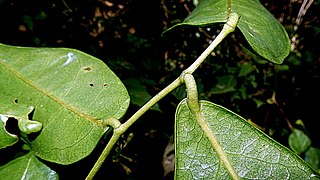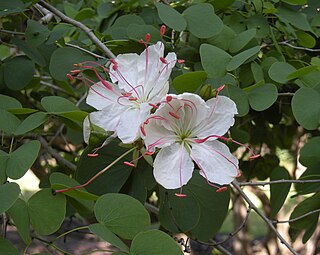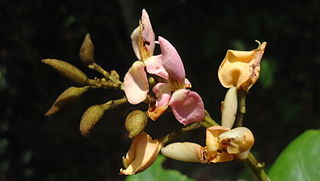
Zornia is a cosmopolitan genus of herbs from the legume family Fabaceae. It was recently assigned to the informal monophyletic Adesmia clade of the Dalbergieae.

Acosmium is a South America genus of flowering plants in the family Fabaceae. Three species are currently recognized. Most Acosmium species have been recently transferred to Leptolobium and one species to the South American Guianodendron while the genus Acosmium itself has been transferred from the tribe Sophoreae to the tribe Dalbergieae in a monophyletic clade informally known as the Pterocarpus clade.

Diplotropis is a genus of trees. It includes ten species native to northern South America, ranging from Colombia and Venezuela to Bolivia and west-central and southeastern Brazil.

Machaerium is a genus of flowering plants in the family Fabaceae, and was recently assigned to the informal monophyletic Dalbergia clade of the Dalbergieae. It contains the following species:
Orphanodendron is a genus of legume in the legume family, Fabaceae. It includes two species of trees native to Colombia, which grow in tropical lowland forest. The genus is in subfamily Faboideae.

Poecilanthe is a genus of flowering plants in the family Fabaceae. It includes 9 species of trees and shrubs native to eastern, southern, and west-central Brazil, Bolivia, Paraguay, Uruguay, and northeastern Argentina. They grow in seasonally-dry tropical forest, woodland, thicket, and riverine forest.

Crotalarieae is a tribe of flowering plants belonging to the family Fabaceae. It includes rooibos (Aspalathus linearis), which is harvested for sale as a tisane.
Guianodendron praeclarum is a South American legume endemic to the Guiana Shield. It is the only member of the genus Guianodendron. It has been segregated from Acosmium based on its unique combination of vegetative and floral traits, and it is related to Diplotropis. It is the only member of the genus Guianodendron.

Lysiphyllum is a genus of flowering plants in the legume family, Fabaceae. It includes nine species of trees, semi-scandent shrubs, and lianas which range from India through Southeast Asia to Australasia. Typical habitats include seasonally-dry tropical forest and woodland, vine thickets, Brigalow and Gidgee scrubland, floodplains, alluvial flats, tidal forest, mangroves, river and stream banks, and occasionally dunes and coral islets. They can grow on diverse soils including calcareous, granitic, and basaltic.

Muellera is a genus of flowering plants in the family Fabaceae. It includes 32 species native to the tropical Americas, ranging from southern Mexico to northern Argentina. It belongs to the subfamily Faboideae.

Luetzelburgia is a genus of flowering plants in the legume family, Fabaceae. It includes 14 species of trees and shrubs native to Brazil, Bolivia, and Colombia. Typical habitat is seasonally-dry tropical lowland woodland and wooded grassland, and occasionally lowland rain forests. The genus belongs to the subfamily Faboideae. It was traditionally assigned to the tribe Sophoreae, mainly on the basis of flower morphology; recent molecular phylogenetic analyses assigned Luetzelburgia into an informal, monophyletic clade called the "vataireoids". Keys for the different species of Luetzelburgia have been published.

The tribe Brongniartieae is one of the subdivisions of the plant family Fabaceae, primarily found in tropical regions of the Americas and in Australia The members of this tribe consistently form a monophyletic clade in molecular phylogenetic analyses. The tribe does not currently have a node-based definition, but morphological synapomorphies have been identified:
"stamens united by filaments in an adaxially open tube; anthers alternately long and basifixed, short and versatile; anther connective inconspicuous; septa present between seeds in pods; aril lateral lobe present and fitting into heel of funicle; fine red glandular processes present in axils; and pollen tricolporate with opercula and no definite endoaperture."

The tribe Dalbergieae is an early-branching clade within the flowering plant subfamily Faboideae. Within that subfamily, it belongs to an unranked clade called the dalbergioids. It was recently revised to include many genera formerly placed in tribes Adesmieae and Aeschynomeneae and to be included in a monophyletic group informally known as the dalbergioids sensu lato. The members of this tribe have a distinctive root nodule morphology, often referred to as an "aeschynomenoid" or "dalbergioid" nodule.

The tribe Sophoreae is one of the subdivisions of the plant family Fabaceae. Traditionally this tribe has been used as a wastebasket taxon to accommodate genera of Faboideae which exhibit actinomorphic, rather than zygomorphic floral symmetry and/or incompletely differentiated petals and free stamens. Various morphological and molecular analyses indicated that Sophoreae as traditionally circumscribed was polyphyletic. This led to a re-circumscription of Sophoreae, which resulted in the transfer of many genera to other tribes. This also necessitated the inclusion of two former tribes, Euchresteae and Thermopsideae, in the new definition of Sophoreae. Tribe Sophoreae, as currently circumscribed, consistently forms a monophyletic clade in molecular phylogenetic analyses. The Sophoreae arose 40.8 ± 2.4 million years ago.

Leptolobieae is a Neotropical, early-branching monophyletic clade of the flowering plant subfamily Faboideae or Papilionaceae that are mostly found in South America.
Staminodianthus is a genus of trees found in South America. It includes three species of trees, from small trees to six meters tall to large trees up to 40 m tall. They are native to the Amazon Basin of northern Brazil, Colombia, Guyana, Peru, and Venezuela, where they grow in humid non-flooded terra-firme forests on sandy or sandy loam soils, gallery forests, and highland savannas.

The tribe Exostyleae is an early-branching monophyletic clade of the flowering plant subfamily Faboideae that are mostly found in Neotropical rainforests.

Limadendron is a genus of small trees in the family Fabaceae. It includes two species native to northern South America, including Colombia, Venezuela, the Guianas, northern Brazil, and Peru. The genus was recently separated from the genus Poecilanthe. It belongs to the tribe Brongniartieae.

Deguelia is a genus of flowering plants in the family Fabaceae. It belongs to the subfamily Faboideae. It includes ten species native to the tropical Americas, ranging from Nicaragua to Bolivia and southeastern Brazil.
















